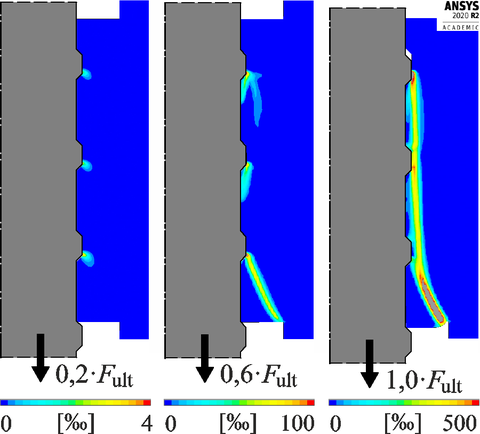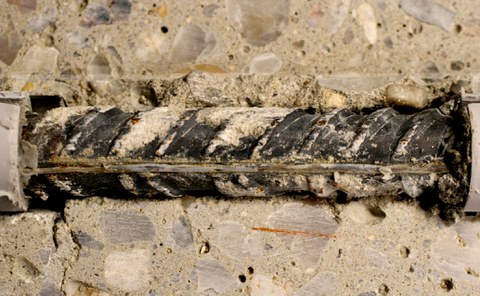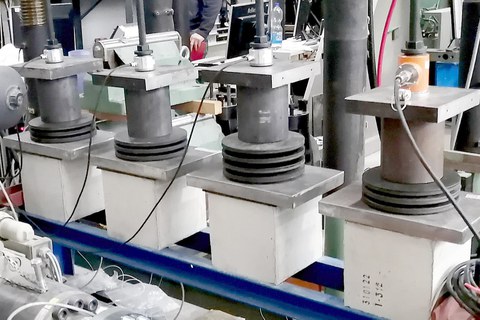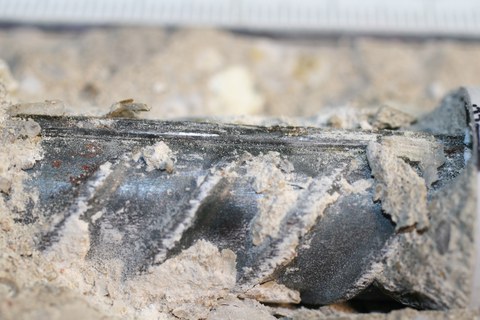Crack width development and local bond relationships due to long-term loading
Table of contents
Project data
| Titel | Title Untersuchung der Rissbreitenentwicklung von Stahlbeton unter Langzeitbelastung anhand lokaler Verbundbeziehungen | Investigations of the crack width development of reinforced concrete under long-term loading based on local bond relationships Förderer | Funding Bundesministerium für Umwelt, Naturschutz, nukleare Sicherheit und Verbraucherschutz (BMUV) / KEK Zeitraum | Period 03/2020 – 02/2023 Leiter | Project manager Prof. Dr.-Ing. Dr.-Ing. E.h. Manfred Curbach Team | Team Dipl.-Ing. Marc Koschemann Rainer Belger, Tino Jänke, Heiko Wachtel, Martin Findeisen, Doreen Sonntag, Philipp Göbel (Probenherstellung, Messtechnik, Versuchsdurchführung | Sample preparation, measurement technology, test execution) |
Supported by: Federal Ministry for the Environment, Nature Conservation, Nuclear Safety and Consumer Protection based on a decision by the German Bundestag under project No. 1501601.
Report in the year book 2023
Bond creep

Calculated crack propagation during pull-out process
As long as reinforced concrete has been used as a composite material, research has been carried out to describe the interaction between reinforcing steel and concrete as precisely as possible. The reason is that the bond behavior of both materials decisively determines crack spacing and widths and, thus, the load-deformation behavior and durability of structural components. A general bond law would be quasi the „Holy Grail“ of reinforced concrete. In the search for it so far, we could only rely on measurement data determined experimentally outside the bond zone.
Within the scope of our investigations, fiber-optic sensors were applied onto reinforcement bars in order to record local and time-related changes in the strain distribution within the bond area. Based on these data, the participation of individual rebar ribs as well as the degree of damage of the surrounding concrete for different loading conditions were derived. Furthermore, local bond-slip relationships were determined in order to formulate general laws of the bond. For the experimental tests, three concretes with strengths between 30 and 70 MPa as well as pull-out specimens and beam end samples were used. A further investigation parameter was the bond length, which was varied in the tests between 16 and 160 mm.
In addition to the static tests, additional test specimens were subjected to long-term loading to investigate the phenomenon of bond creep. For this purpose, a load of 66 % of the static bond strength was applied for a duration of 1,000 to 3,000 hours. As a result of tests carried out so far, a deformation increase by a factor of 2.5 to 3.5 compared to the beginning of loading was observed. With pull-out specimens, approximately twice as large slip values were recorded as those with beam end tests subjected to the same load. In addition to the bond tests, crack growth under long-term loading was investigated using 960 mm long tension tie specimens. Depending on their cross-section, five or eight cracks occurred with an average crack width of 0.20 mm, which increased by about 25 % during the load duration.
Report in the year book 2022
The search for the Holy Grail

Bond zone with fiber-optic sensor after failure
As long as steel reinforced concrete has been used as a composite material, research has been carried out to describe the interaction between reinforcing steel and concrete as precisely as possible. This is because the bond behavior of both materials decisively determines crack spacing and widths and, thus, the load-deformation behavior and durability of structural components. A general bond law would be quasi the „holy grail“ of reinforced concrete. In the search for it so far, we could only rely on measurement data determined experimentally outside of the bond zone.
Within the scope of current investigations, fiber-optic sensors are applied onto reinforcement bars in order to record local and time-related changes in the strain distribution within the bond area. Based on these data, the participation of individual rebar ribs as well as the degree of damage of the surrounding concrete for different loading conditions is derived. Furthermore, local bond-slip relationships are determined in order to formulate general laws of the bond.
For the experimental tests, three concretes with strengths between 30 and 70 MPa as well as pull-out specimens and beam end samples are used. A further investigation parameter is the bond length, which is varied in the tests between 16 and 160 mm.
In addition to the static tests, further test specimens are subjected to long-term loading to investigate the phenomenon of bond creep. For this purpose, a load of 66 % of the static bond strength is applied for a duration of 1,000 to 3,000 hours. As a result of tests carried out so far, a deformation increase by a factor of 2.5 to 3.5 compared to the beginning of loading was observed. With pull-out specimens, approximately twice as large slip values were recorded as those with beam end tests subjected to the same load. In addition to the bond tests, crack growth under long-term loading is investigated using 960 mm long tension tie specimens. Depending on their cross-section, 5 or 8 cracks occurred with an average crack width of 0.20 mm, which increased by about 25 % during the load duration.
Report in the year book 2021
Slow but steady

Pull-out specimens under sustained loading
For the economic use of reinforced concrete components, cracks in the concrete are needed. Only then does the reinforcement effectively participate in the load transfer through the bonding effect. However, cracks are also weak points of reinforced concrete elements and can be the cause of leaks and reinforcement corrosion and thus lead to deterioration. More and more often, buildings such as interim nuclear storage facilities are being used for longer than originally planned. Respectively long loading durations cause the crack widths to increase, which is mainly due to creep effects in the bond zones. Previous findings are based on data determined experimentally outside of the bond zone.
In this project, the bond behaviour and the bond stress distribution of reinforcing steel in normal-strength concretes under long-term loading are investigated. For this purpose, pull-out and beam-end specimens are used made of concretes with strengths between
30 MPa and 70 MPa. Another test parameter is the bond length, which is varied between
16 mm and 160 mm in the tests. In addition to classic displacement transducers, the bond behaviour is detected also by hair-thin fibre-optic sensors. Applied to the pull-out bar, it records local and time-related changes in the strain distribution within the bond zone during the tests. Thus, the participation of the individual ribs for different load levels as well as the local damage to the concrete is determined in static tests.
For the creep tests, further samples were subjected to a sustained load of 66% of the static bond strength. After a duration of 1,000 h, a slip increase by a factor of 2.5 to 3.5 was observed compared to the start of loading. The slip values recorded with pull-out specimens were about twice as large as those recorded with beam end tests subjected to the same load. In addition to the bond tests, crack growth under long-term loading is investigated using tension tie specimens of 960 mm length. Depending on the concrete cover, 5 or 8 cracks appeared with an average crack width of 0.20 mm, which increased by about 25% with increasing load duration.
Report in the year book 2020
Unbox the black box

Bond zone with sensor fiber after failure
Cracks belong to the material reinforced concrete and are necessary for its load-bearing mechanism. However, cracks are also weak points of reinforced concrete elements and can be the cause of leaks and reinforcement corrosion and thus lead to deterioration. Buildings, such as interim nuclear storage facilities, are often used for longer than planned. This raises the question of how long-term loads affect the crack widths of reinforced concrete. The bond behaviour between reinforcing steel and concrete has a decisive influence on the cracking behaviour. Existing models are based on data determined experimentally at the beginning and end of a bond zone. Fibre-optic measurement technology opens up the possibility of recording local and time-related changes within the bond area.
Current investigations at the Institute for Concrete Structures are dealing with the bond behaviour and the bond stress distribution of reinforcing steel in normal-strength concretes under long-term loading. For three different specimen types and different bond lengths, the specific static bond strength is first determined experimentally. Subsequently, further samples are loaded with up to 70% of the static reference load for up to 10,000 hours. The measurement of the bond behaviour is carried out by conventional displacement transducers and fibre-optic sensors. These hair-thin sensors are applied to the pull-out bars and enable the quasi-continuous recording of strains within the bond zone during the tests. The application location on the reinforcement bar has a significant influence. In preliminary tests, the sensors were applied at different positions on the bar with the help of grooves to identify strain differences within the reinforcement cross-section. The fine local resolution of 0.65 mm per measured value allows insight into the local force transmission from reinforcement to concrete and the representation of stress curves for any load state. As a result of the deterioration of the concrete during load increase and creep under permanent load, the distribution of bond forces within the bond zone changes, which is accompanied by increasing deformations and growing crack widths.
